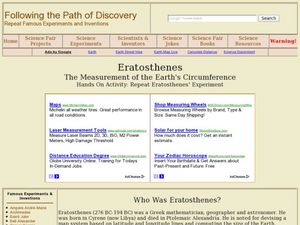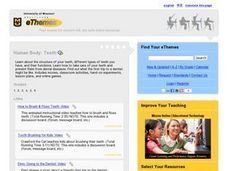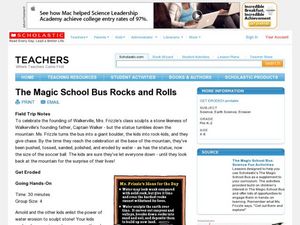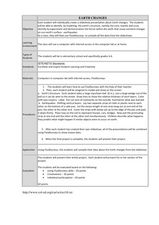Curated OER
Science Unit Lesson Five
Sixth graders review how and which plants operate in terrariums. In groups, they follow instructions to make their own terrarium and place different types of plants in it. To end the lesson, they review the steps in the water cycle and...
American Chemical Society
Why Does Water Dissolve Salt?
Individuals explore solubility by modeling how water dissolves salts. They then view a video and compare how well water and alcohol dissolve salts, relating their comparisons to the structure of each molecule.
American Chemical Society
Using Chemical Change to Identify an Unknown
If you discover an unknown powder, how do you determine if it is safe? Lesson uses four different tests to identify the properties of various powders that appear the same. Then scholars get an unknown powder and have to determine which...
Curated OER
Simple Harmonic Motion
Students explore the theory of simple harmonic motion (SHM) by performing hands-on, practical application experiments. In this harmonic motion lesson, students use strings of various lengths and bobs of different weights to create a...
Curated OER
Determining the Geologic History of Rocks from a Gravel Deposit
Students apply the scientific method to identify rocks from glacial deposits, hypothesize how they got there and then test their hypothesis. They are given the experience of active, hands-on inquiry.
Curated OER
Placebo - 1
Students explore the placebo effect, thus producing the positive effects of acupuncture without needle insertion. Students discuss echolocation. They participate in hands-on/minds-on activities in reflected sound waves. They...
Alabama Learning Exchange
The Water Cycle
Students participate in a hands-on experience with the water cycle. They experience different parts of the water cycle through experiments and exploring the Internet. They create a poster or model of the water cycle and explain each part...
Curated OER
Animal Life Cycles
Students participate in numerous activities to gather information about parts of the life cycle. In this life science lesson, the teacher choose from a number of activities to create or support an interdisciplinary unit about the life...
Curated OER
Remembering the Respiratory System
Sixth graders analyze the components of the respiratory system. In this respiratory system lesson, 6th graders participate in hands on experiments and activities to identify the functions of the major organs of the respiratory system.
Curated OER
Heat: Mini Unit
Students experiment with heat. In this physical science lesson, students engage in hands-on activities to develop concepts related to heat. Students offer explanations for their observations using given vocabulary.
Curated OER
It All Began With a Bean
Students explore human anatomy by participating in hands-on activities. In this digestive system lesson, students read the book It All Began With a Bean and discuss the process of food digestion in our body. Students utilize soda...
Curated OER
Eratosthenes
Students examine what Eratosthenes is and the history behind him. In this earth lesson students complete a hands on activity to repeat Eratosthenes' experiment.
Curated OER
Survival Under a Rock
Pupils investigate ways that animals adapt to their environments through hands-on activities using isopods and an interactive video.
Curated OER
Dig This Dinosaur Relief Lesson
Students create low-fire ceramic relief sculptures of dinosaur bones. They incorporate art history, aesthetics, and criticism with hands on activity. Students work together to draw an enlarged skeleton on butcher paper. The Stegosaurus...
Curated OER
Scales, Scutes, and Skins
Students identify the various adaptations of reptiles and amphibians. After distinguishing between reptiles and amphibians, students discuss the ways in which their adaptations aid in their survival. They participate in a hands on...
Alabama Learning Exchange
Why Roots, Stems, and Leaves are Important
Young scholars use the Internet to research the importance of leaves, stems and roots to plants. They participate in a hands-on experiment to identify the functions of different plant parts.
Curated OER
Sensational Slime
Young scholars predict, observe and draw conclusions while working on an experiment with "slime." Students accurately record observations and draw conclusions about the experiment.
Curated OER
Three Clouds Activity
Students explore how clouds are produced through three different age-appropriate hands-on experiments.
Curated OER
Earth's Radiation Budget
Twelfth graders explore the Earth's radiation budget using Earth radiation Budget Experiment (ERBE) data archived at the IRI/LDEO Climate Data Library. They use photometers and light sources to work through several hands-on activities...
Curated OER
Human Body: Teeth
Students examine the structure of teeth, the different types of teeth and their functions. They discuss how to take care of their teeth and how to prevent dental diseases by viewing movies, participating in hands-on experiments and...
Curated OER
The Magic School Bus Rocks and Rolls
Students participate in a science experiment to show them the power that water erosion has to sculpt stone. They explore how running water moves earth and creates new landforms.
Curated OER
What are Properties of Wood?
Students use hands on scientific observation to determine characteristics of wood. They work directly with the materials and record their observations. Students test if wood absorbs water, if wood floats or sinks, and if all wood...
Curated OER
EXPLORING OUR HUMAN BODIES
Students observe and investigate the human skeletal and muscle systems. They become aware of the versatility of movement as well as gain experience through the use of diagrams and hands on activities. An extensive vocabulary is covered...
Curated OER
Earth Changes
Students investigate the earth's structural layers by participating in hands-on activities. They identify the earth's structure and investigate earthquakes.























